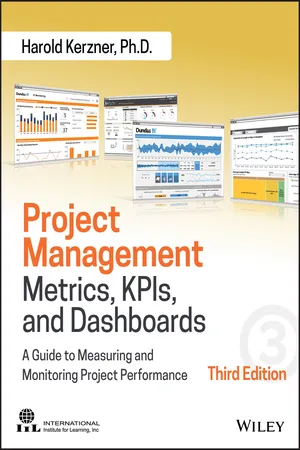
Project Management Metrics, KPIs, and Dashboards
A Guide to Measuring and Monitoring Project Performance
Harold Kerzner
- English
- ePUB (mobile friendly)
- Available on iOS & Android
Project Management Metrics, KPIs, and Dashboards
A Guide to Measuring and Monitoring Project Performance
Harold Kerzner
About This Book
Harold Kerzner's essential strategies on measuring project management performance
With the growth of complex projects, stakeholder involvement, and advancements in visual-based technology, metrics and KPIs (key performance indicators) are key factors in evaluating project performance. Dashboard reporting systems provide accessible project performance data, and sharing this vital data in a concise and consistent manner is a key communication responsibility of all project managers.
This third edition of Kerzner's groundbreaking work, Project Management Metrics, KPIs, and Dashboards: A Guide to Measuring and Monitoring Project Performance, helps functional managers gain a thorough grasp of what metrics and KPIs are and how to use them. Plus, this edition includes new sections on processing dashboard information, portfolio management PMO and metrics, and BI tool flexibility.
• Offers comprehensive coverage of the different dashboard types, design issues, and applications
- Provides full-color dashboards from some of the most successful project management companies, including IBM, Microsoft, and others
- Aligns with PMI's PMBOK® Guide and stresses value-driven project management
- PPT decks are available by chapter and a test bank will be available for use in seminar presentations and courses
Get ready to bolster your awareness of what good metrics management really entails today—and be armed with the knowledge to measure performance more effectively.
Frequently asked questions
Information
Table of contents
- Cover
- Title Page
- Copyright
- Preface
- 1: The Changing Landscape of Project Management
- 2: The Driving Forces for Better Metrics
- 3: Metrics
- 4: Key Performance Indicators
- 5: Value-Based Project Management Metrics
- 6: Dashboards
- 7: Dashboard Applications
- 8: The Portfolio Management PMO and Metrics
- Index
- EULA